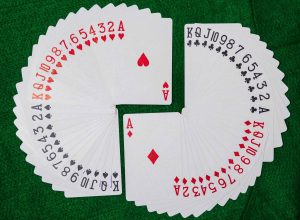Poker is one of the world’s most popular pastimes, with millions participating worldwide. Players in many parts of the world can find live poker rooms, online poker sites, and poker home games, and it’s never been easier to find a place to play poker.
While getting into a game may be simple, learning how to play poker can be difficult. The Berkat Poker’s Ultimate Beginner’s Guide to Poker contains everything you need to know about the rules, common terms, and other nuances of the most popular poker variants played worldwide. This guide will teach you how to play poker, from the most basic rules to understanding a full round of betting.
What are the fundamental rules of poker?
Poker encompasses a variety of card games, each with its own set of rules. Texas Hold’em is the most popular poker game in the world.
Omaha and Five Card Draw are two other popular games in the world’s largest poker rooms. While each poker variant has its own set of rules, the fundamentals of betting, bluffing, common terms, and poker hand rankings apply to nearly all of them.
Berkat Poker’s Ultimate Beginner’s Guide to Poker covers the fundamentals of three of the world’s most popular poker variants: Texas Hold’em, Five Card Draw, and Omaha.
Texas Hold’em Rules
The World Series of Poker Main Event in 2003 catapulted the world’s most popular card game into mainstream prominence. Chris Moneymaker, an Americas Cardroom Team Pro, stunned the world by winning the prestigious poker tournament for a $2.5 million first-place prize, and interest in Texas Hold’em skyrocketed worldwide.
Texas Hold ’em aims to create the best five-card hand possible by combining two hole cards and five community cards. The first round begins with each player receiving two hole cards, which are dealt face down and can only be seen by the player holding them until the hand is over.
The pre-flop betting round begins when each player receives their two-hole cards. The dealer then places the first three of five community cards on the table. The flop is made up of three cards that are face up.
Another betting round begins after the flop is shown on the board. Following the flop betting round, another community card (also face up) hits the board, known as the turn.
Following the turn betting round, the dealer places the fifth card on the board, known as the river. The final round of betting begins with the river dealing, after which all remaining players reveal their hole cards. The winner is the player who has the best five-card hand using any combination of hole cards and community cards.
Five Card Draw Poker Rules
Although it is not as popular as Texas Hold’em, it is still played at the World Series of Poker every year. Some online poker rooms also offer Five Card Draw games, and most video poker machines in live casinos do as well.
Prior to the rise of Texas Hold’em poker in the 2000s, Five Card Draw was the most popular poker variant in the world. Each player in a Five Card Draw game is dealt five hole cards, all of which are face down and visible to only the player holding them.
Following the transaction, a betting round begins. Following that betting round, all players have the option to discard as many cards as they want from their hand, with the dealer replacing those discards with new cards.
A final round of betting occurs after all players have discarded and drawn their desired number of cards. All remaining players (those who have not folded at some point during the hand) then show their cards, and the best five-card hand wins.
Omaha Poker Rules
Omaha Poker is similar to Texas Hold’em, but there are a few key differences. Each player is dealt four-hole cards rather than two in an Omaha game.
Like in Texas Hold’em, the dealer places five community cards on the table for three betting rounds known as the flop, turn, and river. To make the best hand in Omaha, players must use exactly two hole cards in combination with three community cards. The best hand, as expected, wins.
Additional Poker Variations
In addition to the three most common types of poker, you should be aware of other variations. Other poker variations include:
- Pineapple Mania
- 7 Card Stud
Rankings of Poker Hands
To determine the winner of each hand, most poker variants employ the same system of poker hand rankings. Hands such as the royal flush, straight flush, four-of-a-kind, full house, and others are included in the standard poker hand rankings.
The royal flush is the strongest and most difficult hand to achieve in a poker game. A royal flush is a ten-to-ace straight with all of the cards in the same suit.
Royal flushes are at the top of the poker hand rankings, and all hands below it lose in a head-to-head matchup. The lower the likelihood of a hand being made, the higher it ranks in the poker hand rankings.
For example, if you draw five random cards from a standard 52-card deck, the odds of getting a royal flush are 649,739-to-1. In comparison, the lowest-ranking hand in the rankings, the high card, has an equal chance of being drawn at random from the deck.
Here’s a quick rundown of the top poker hands, from strongest to weakest:
- The Royal Flush
- Flush Straight
- Four in a Row
- Complete House
- Flush
- Straight
- Three in a Row
- a pair of
- a single pair
High Score
Some of the hands-on parts of this list overlap. A straight flush, for example, is made up of a straight and a flush in the same hand. However, the straight flush outranks both the flush and the straight. When two hands of the same strength compete, the strongest high card wins.
How to Play a Poker Game
Poker variants can have different game rules, betting structures, and common terms. However, most poker games operate in the same way in terms of game execution.
Almost all poker games begin with at least two cards dealt to each player. Following that, players begin betting. The first designated player (according to the betting rules of the game) has the option to call, bet, or fold.
The action then moves clockwise around the table to the dealer’s left until each player has the opportunity to bet, call, raise, check, or fold. The next round of action begins after each player has had a chance to bet.
How to Play Texas Hold’em or Omaha Poker
A round of Texas Hold’em begins with the blinds being posted by the two players in the small and big blind positions. The blinds are mandatory bets that rotate around the table, one player clockwise after each hand.
The stakes of the game are determined by the size of the blinds. For example, a $1/$2 No-Limit Hold’em game denotes a no-limit Texas Hold’em game with a $1 small blind and a $2 big blind.
Dealt Cards
The dealer begins dealing cards to each player once the players in the blinds have placed their mandatory bets. Starting with the small blind, the dealer deals one card at a time until all players have two hole cards in front of them for Texas Hold’em or four cards for Omaha.
Pre-flop
The pre-flop betting round begins after the deal. The player directly to the left of the big blind (known as the “under-the-gun”) can call the big blind amount, raise to a higher amount, or fold.
For example, suppose the first player to act decides to raise. In this case, the under-the-gun player must raise to at least $4 (the amount of the $2 big blind plus the $2 minimum raise).
If the player under the gun raises to $4, the player to his or her immediate left has the option to call (match the $4) bet, raise (increase the amount of the bet), or fold. In this manner, the action moves clockwise around the table until each player has the opportunity to call, raise, or fold.
The River, Flop, and Turn
Following the conclusion of the pre-flop betting round, the dealer places three community cards on the board, known as the flop. Then, another betting round begins, this time with the player in the small blind or the first still-active player on the small blind’s left.
The dealer places a fourth community card on the board at the end of the flop betting round. This is known as the turn or fourth street card.
After the turn betting round is completed, the dealer places the fifth and final community card on the table. The river, or fifth street, is the name given to this card.
Following the river’s appearance on the board, all remaining players engage in a final betting round, beginning with the player to the left of the dealer. After this round, all remaining players reveal their hole cards, and the player with the best hand wins. If there is a tie, the player with the highest card wins.
How to Play a Five-Card Draw Round
The primary betting structure in most Five Card Draw games is either blinds or antes. The blinds function similarly to those in Texas Hold’em or Omaha, while the antes are a forced bet that serves as a buy-in for each player before each hand.
After posting the blinds or antes, the dealer deals five cards to each player, one at a time. The first betting round begins when all players have five cards.
After all players have had the opportunity to check, bet, raise, or fold, each player may discard as many cards from their hand as they wish and replace them with new cards from the undealt portion of the deck.
If a player wishes to keep all five cards, he or she may “stand pat” by not discarding or drawing any new cards. Following the discard round, there is another betting round.
After the final betting round, all remaining players reveal their hole cards. The pot is won by the player with the best five-card hand.
How to Bet on Poker
Texas Hold’em, Omaha, and Five Card Draw are all games with different betting structures. A game’s betting structure can drastically alter strategy.
No-limit, pot-limit, and fixed-limit betting structures are the most commonly used in poker games around the world.
Limitless and Pot-Limit
No-limit betting allows any player to bet their entire stack at any time. Pot-Limit structures restrict the maximum size of a bet or raise to the size of the pot already in play.
Fixed-Limit
Fixed-limit betting requires a predetermined maximum bet and raise for each betting round. Fixed-limit games, also known as simply “limit” betting, play very differently than no-limit or pot-limit games.
Texas Hold’em Betting
No-Limit Texas Hold’em is the most popular poker game in the world. Texas Hold’em with a no-limit betting structure is referred to as No-Limit Hold’em.
Any player in a No-Limit Hold’em hand can go all-in at any time, putting all of their chips into the pot. Any betting round, including the pre-flop, flop, turn, and river, allows players to go all-in.
If a player raises without any previous calls or bets, that player is said to be “open raising” or “opening,” and if the first player to enter a pre-flop pot calls the big blind, that player is said to be “limping.
Re-raising against the original raiser in any betting round is referred to as “three-betting,” while raising against a three-bet is referred to as a “four-bet,” and raising a four-bet is referred to as a “five-bet.”
This naming for raises continues, but anything larger than a five-bet is uncommon in a No-Limit Hold’em game. Pre-flop five-bets frequently force a player to go all-in.
The “continuation bet,” or “c-bet,” is another term used in Texas Hold’em. A continuation bet occurs when the last player who raised in the previous betting round makes the first bet in the next betting round.
Players in No-Limit Texas Hold’em games can go “all-in” anytime, putting all their chips into the pot. Texas Hold’em can be played with a pot-limit or fixed-limit betting structure as well.
Omaha Sports Betting
Omaha is similar to Texas Hold’em in that players are dealt four-hole cards rather than two. Pot-Limit Omaha (PLO) is the world’s second most popular poker game, while No-Limit Omaha (NLOP) is uncommon.
Pot-Limit Omaha has the same betting terms as No-Limit Hold’em. The maximum allowed bet or raise in any pot-limit game, however, is equal to the amount of money already in the pot.
In a PLO game, the “pot” is calculated as the amount in the middle before the previous bet, plus that previous bet, plus the amount in the pot if you called. You can then increase it by a maximum of that amount once you’ve calculated it.
Fortunately for players, online poker sites perform this calculation for them. In a PLO game, betting or raising the maximum is known as “potting,” and declaring “pot” in a live game commits you to making a pot-sized bet or raise.
Five Card Draw Betting
Five Card Draw games have no-limit, pot-limit, and fixed-limit betting structures. Unlike Texas Hold’em or Omaha, this game has no community cards, and betting is limited to two rounds.
Following the cards’ distribution, each player can bet, raise, call, or fold. The first betting round begins when all players have a chance to act.
Following that, each player is free to discard as many cards as they want and replace them with new cards from the undealt deck. After the discard round, the final betting round begins.
Knowing When to Place a Bet
The best advice for a new poker player is to raise or fold the majority of the time. When all other options are exhausted, reserve calling and checking for available spots. Some players prefer to bet their best and worst hands, while others play more cautiously with medium-strength hands.
This strategy requires you to sometimes win with the worst hand, and your opponents will sometimes have to call when you have a very strong hand because they know you can bluff.
Examine your opponent’s hand
When deciding whether to bet or not, consider what your opponent might have. Then, when you’re feeling hesitant, check to see what the next card brings.
Some players also prefer to bet more when they are the last to act and check more frequently when they are the first to act. There are no poker rules for determining when to bet; just common sense and your best guess.
The most crucial poker terms
Poker chips are used to represent money at the table. In a cash game, the various chip colors represent varying dollar amounts and are redeemable for real money. Tournament chips have no monetary value. A T10,000 chip, for example, is not the same as $10,000.
Banker – In a home game, the banker is in charge of all cash and chip exchanges for all players. To facilitate transactions for private online games, the banker can use a payment processor such as PayPal or Venmo.
Betting Limits – In games with a limited betting structure, betting limits denote the maximum allowed bets and raises. For example, in a $4/$8 Limit Omaha Hi-Lo game, the maximum bet/raise for the pre-flop and flop betting rounds is $4, and the maximum bet/raise for the turn and river betting rounds is $8.
Fixed Limit – Also known as simply “limit,” fixed-limit games limit the maximum bet or raise allowed. In most games, the early betting rounds allow for a “small bet,” and the later rounds allow for a “big bet.” For example, in a $4/$8 Limit Texas Hold’em game, the first two betting rounds allow for a “small bet,” and the final two rounds allow for a “big bet.”
Pot Limit – In pot limit games, the maximum bet or raise is the size of the pot. Pot-Limit Omaha is the most popular game that uses this betting structure, but pot-limit betting rules can be applied to almost any game.
No Limit – Games with a no-limit betting structure allowing players to throw in all of their chips at any time.
Table Stakes – The amount of the big blinds or betting limits in a given poker game is denoted by table stakes. A $1/$2 No-Limit Texas Hold’em game, for example, has a $1 small blind and a $2 big blind. The stakes in limit games represent the maximum allowed bets and raises.
How to Improve Your Poker Skills
Success at the poker table is more difficult to achieve in 2021 than it has ever been. However, there are numerous training sites, free strategy resources, poker videos, and online tools available in today’s poker landscape.
A player who devotes time to poker study will always have an advantage over another player who needs to put in the effort. A solid poker strategy starts with a basic understanding of common terms, poker hand rankings, betting rules, and bankroll management.
Poker players can study the game using a variety of resources. Away from the table, studying poker is critical to winning in the modern era.
The good news is that there are numerous poker strategy resources available online. Many books are also available to help you learn how to play poker. In addition, professionals explain their thoughts on poker strategy in videos on online poker training sites. The pros will teach you through their play by analyzing hands after the game is over in these videos.
There are numerous ways to improve your game, depending on whether you prefer cash games or tournaments. Simple articles like this one that teach you the rules of poker can teach you a lot. However, feel free to delve into in-depth poker strategy books that cover game theory.
You can even find educational apps and software that will help you learn poker by analyzing your play online and identifying flaws.
Poker pro tips for improving your game
America’s Cardroom Team Pro Ebony Kenney believes that the amount of work an aspiring poker player does away from the table directly impacts his or her results at the table.
“The most important tip I can give is, to be honest with yourself and to take the time to learn,” Kenney says. “With all of the free content available now, it’s never been easier to improve at poker.” So grab a pen and paper, jot down some notes, and make a list of your strengths and weaknesses.
Is it Simple to Learn Poker?
Like any other game or skill, learning is a function of your commitment to practicing. Poker’s game mechanics are simple enough to learn in an afternoon. How much you practice will determine whether you develop the skills to consistently win Poker games or even win money online.
It’s also critical to streamlining your practice. Simply playing poker is different from studying and putting in the effort to improve. Playing small games at first will help you keep your bankroll safe until you’re strong enough to beat bigger games. Then, talking through hands with a friend or a coach can help you advance much more quickly.
Online forums can also be of great assistance. Thousands of people are out there trying to learn the rules of poker, just like you. Finding a community can help you maintain your study routine while also providing you with honest feedback on your performance.
What is the best way to play poker without using real money?
Playing at free online poker sites is a great way to get started with poker. Zynga Poker, PlayWSOP, PlayWPT, and Replay Poker are all free poker apps that provide online games with play money stakes.
Many of the world’s most popular online poker sites also provide play money games. Another option for free poker is to play with friends using something other than money, such as plastic chips.
Tournaments vs. Cash Games
While the rules are generally the same, there are some significant differences between cash games and tournament play. In a tournament, you can only play with the chips in front of you. Generally, as the blinds rise, the stacks become much shorter. Cash games frequently have an average stack of more than 100 big blinds.
To be a successful tournament player, you must learn how to play a short stack and how to play against short stacks. Conversely, learning how to use a large stack correctly is one of the most significant differences between cash games and tournaments.
Cash game players must be patient as well as aggressive, which is a difficult combination to achieve. The ability to move to a better table and choose when and where to play is a significant advantage for cash game players who can seek out the best games. Tournament participants must remain at their assigned table and deal with their opponents.
How many people are required to play poker?
Poker games can be played with as few as two people. A one-on-one poker game is known as a “heads-up” game, and heads-up matches are common among high-stakes players.
The maximum number of players seated at any one table in Texas Hold’em is generally nine, though some poker rooms will seat ten players at a table.
The maximum number of players allowed varies depending on the game. In general, ten players at a table is a good rule of thumb for most games.
Home poker vs. online poker
Home poker games are popular all over the world, and the players who gather for a home game are frequently friends and associates. A home poker game often has a more relaxed and loose atmosphere than a casino game.
Stepping into the world of online poker introduces a completely new level of competition. When you play online real-money poker, you are frequently up against strong competition.
The feel of online poker is very different from that of a home game, and winning at online poker generally necessitates more study work than playing at home.




